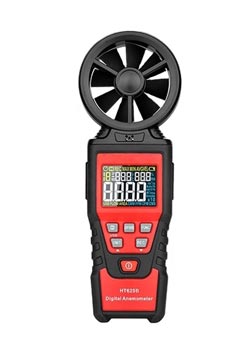Probe selection for anemometers
The flow velocity measurement range from 0 to 100m/s can be divided into three segments: Low speed: 0 to 5m/s. Medium speed: 5 to 40m/s. High speed: 40 to 100m/s.
The thermal probe of the anemometer is used for precise measurements from 0 to 5m/s.
The rotor probe of the anemometer is ideal for measuring the flow velocity of 5 to 40m/s.
Pitot tubes give the best results in the high speed range.
An additional criterion for the correct selection of an anemometer’s flow probe is temperature, usually the temperature of the thermal sensor of an anemometer is about +-70C. The rotor probe of the special anemometer can reach 350C. Pitot tubes are used above +350C.
Thermal probes for anemometers
The working principle of the thermal probe of the anemometer is based on the cold impact airflow to take away the heat on the heating element. With the help of an adjustment switch, to keep the temperature constant, the adjustment current is proportional to the flow rate. When using thermal probes in turbulent flow, airflow from all directions hits the thermal element simultaneously, affecting the accuracy of the measurement results. When measuring in turbulent flow, thermal anemometer flow sensors tend to have higher indications than rotor probes. The above phenomena can be observed during pipeline measurement. Depending on the design that manages the turbulence in the pipe, it can occur even at low speeds.
Therefore, the anemometer measurement process should be carried out on the straight section of the pipeline. The starting point of the straight line should be at least 10×D before the measurement point (D=pipe diameter, in CM); the end point should be at least 4×D behind the measurement point. The fluid section must not have any obstructions (edges, re-suspensions, objects, etc.).
Rotor probe for anemometer

The working principle of the rotator probe of the anemometer is based on converting the rotation into an electrical signal. First, through a proximity induction head, the rotation of the runner is “counted” and a pulse series is generated, and then converted by the detector. Get the speed value.
The large-diameter probe (60mm, 100mm) of the anemometer is suitable for measuring turbulent flow with medium and small flow velocity (such as at the pipe outlet). The small-diameter probe of the anemometer is more suitable for measuring the airflow with the cross-section of the pipeline more than 100 times larger than the cross-section of the expedition head.
